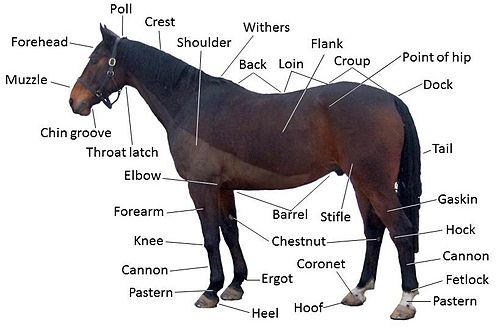Post by Admin on Dec 16, 2015 16:30:45 GMT -7

back: the area where the saddle sits, beginning at the end of the withers, extending to the last thoracic vertebrae (colloquially includes the loin or "coupling," though technically incorrect usage)
barrel: the body of the horse, enclosing the rib cage and the major internal organs
buttock: the part of the hindquarters behind the thighs and below the root of the tail
cannon or cannon bone: the area between the knee or hock and the fetlock joint, sometimes called the "shin" of the horse, though technically it is the metacarpal III
chestnut: a callosity on the inside of each leg
chin groove: the part of the horse's head behind the lower lip and chin, the area that dips down slightly on the lower jaw
coupling: see "Loin" below
coronet or coronary band: the ring of soft tissue just above the horny hoof that blends into the skin of the leg
crest: the upper portion of the neck where the mane grows
croup: the topline of the hindquarters, beginning at the hip, extending proximate to the sacral vertebrae and stopping at the dock of the tail (where the coccygeal vertebrae begin); sometimes called "rump"
dock: the living part of the tail, consisting of the coccygeal vertebrae, muscles and ligaments. Sometimes used colloquially to refer to the root of the tail, below.
elbow: The joint of the front leg at the point where the belly of the horse meets the leg. Homologous to the elbow in humans
ergot: a callosity on the back of the fetlock
face: the area between the forehead and the tip of the upper lip
fetlock: sometimes called the "ankle" of the horse, though it is not the same skeletal structure as an ankle in humans; known to anatomists as the metacarpophalangeal (front) or metatarsophalangeal (hind) joint; homologous to the "ball" of the foot or the metacarpophalangeal joints of the fingers in humans
flank: where the hind legs and the barrel meet, specifically the area right behind the rib cage and in front of the stifle joint
forearm: the area of the front leg between the knee and elbow, consisting of the fused radius and ulna, and all the tissue around these bones; anatomically, the antebrachium.
forehead: the area between the poll, the eyes and the arch of the nose
forelock: the continuation of the mane, which hangs from between the ears down onto the forehead of the horse
frog: the highly elastic wedge-shaped mass on the underside of the hoof, which normally makes contact with the ground every stride, and supports both the locomotion and circulation of the horse
gaskin: the large muscle on the hind leg, just above the hock, below the stifle, homologous to the calf of a human
girth or heartgirth: the area right behind the elbow of the horse, where the girth of the saddle would go; this area should be where the barrel is at its greatest diameter in a properly-conditioned horse that is not pregnant or obese
hindquarters: the large, muscular area of the hind legs, above the stifle and behind the barrel
hock: the tarsus of the horse (hindlimb equivalent to the human ankle and heel), the large joint on the hind leg
hoof: the foot of the horse; the hoof wall is the tough outside covering of the hoof that comes into contact with the ground and is, in many respects, a much larger and stronger version of the human fingernail
jugular groove: the line of indentation on the lower portion of the neck, can be seen from either side, just above the windpipe; beneath this area run the jugular vein, the carotid artery and part of the sympathetic trunk
knee: the carpus of the horse (equivalent to the human wrist), the large joint in the front legs, above the cannon bone
loin: the area right behind the saddle, going from the last rib to the croup, anatomically approximate to the lumbar spine
mane: long and relatively coarse hair growing from the dorsal ridge of the neck
muzzle: the chin, mouth, and nostrils of the face
pastern: the connection between the coronet and the fetlock, made up of the middle and proximal phalanx
poll: commonly refers to the poll joint at the beginning of the neck, immediately behind the ears, a slight depression at the joint where the atlas (C1) meets the occipital crest; anatomically, the occipital crest itself is the "poll"
root of the tail or root of the dock: the point where the tail is "set on" (attached) to the rump; Sometimes also called the "dock"
shoulder: made up of the scapula and associated muscles, runs from the withers to the point of shoulder (the joint at the front of the chest, i.e. the glenoid); the angle of the shoulder has a great effect on the horse's movement and jumping ability, and is an important aspect of equine conformation
splints: bones found on each of the legs, on either side of the cannon bone (8 total); partially vestigial, these bones support the corresponding carpal bones in the forelimb, and the corresponding tarsal bones in the hindlimb; anatomically referred to as Metacarpal/Metatarsal II (on the medial aspect (inside)) and IV (on the lateral aspect (outside))
stifle: corresponds to the knee of a human, consists of the articulation between femur and tibia, as well as the articulation between patella and femur
tail: the long hairs which grow from the dock; may also include the dock
throatlatch (also, throttle, throatlash, throat): the point at which the windpipe meets the head at the underside of the jaw,[3] corresponding to where the eponymous part of a bridle goes.
withers: the highest point of the thoracic vertebrae, the point just above the tops of the shoulder blades, seen best with horse standing square and head slightly lowered; the height of the horse is measured at the withers.
Source: en.wikipedia.org/wiki/Equine_anatomy#External_anatomy
